« Prev Next »

For large-scale coastal dune development there needs to be a suitable wind regime, large reserves of sand and suitable nearshore, beach and back beach morphology (Pye 1983, Iversen & Rasmussen 1999, Sherman & Bauer 1993). Depending on the characteristics and availability of the sediment supply, dominant wind velocity and direction, moisture and vegetation present, and the geomorphology of the nearshore and beach face, dunes of various size and morphology are formed (Short & Hesp 1982). These can be divided into dunes that form from the direct supply of sediment from the beach face (termed ‘primary dunes' by Davies 1980) and features that are formed from the subsequent modification of primary dunes (‘secondary dunes').
Transport of Sand by Wind (Aeolian Transport)
There are three forces that determine if, and how, an individual grain of sediment will be transported by wind (Figure 1). Gravity acts to keep the grain at the ground surface (FG), there is a drag component that moves the gain along the ground surface (FD) with the wind direction and a lift force (or shear stress: FL) produced by pressure differences created by the movement of wind over the surface of a stationary grain. This lift force is the result of a relatively high velocity flow across the top of the particle, and lower velocities across the middle and lower parts of the sand grain. A stationary grain will begin to first vibrate, and then move when the shear stress at the grain surface exceeds a specific critical value (i.e., the vertical lift exceeds gravitational force, FL>FG) (Figure 1). This value is known as the critical shear stress, or the threshold velocity, and results in the grain being lifted vertically into the air (Bagnold 1941, Pye 1983, Sherman & Hotta 1990, Sherman & Bauer 1993).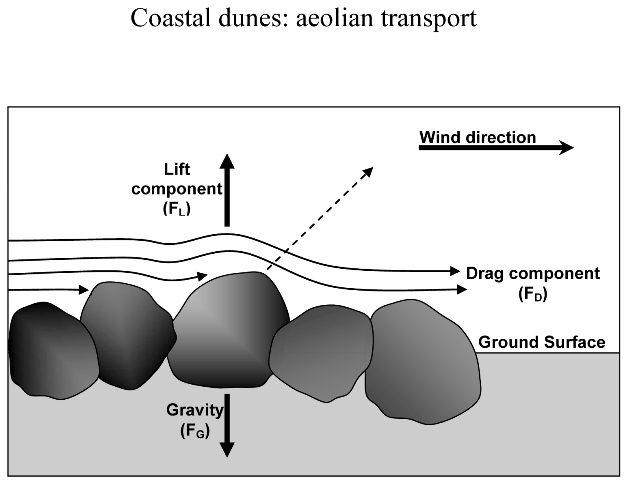
Transport by wind takes place almost entirely within 0.5 m of the ground surface with nearly 90% of this movement within 2.5 cm of the surface (Bagnold 1941). Once the grain is lifted it is transported downwind in a parabolic trajectory. The speed and distance that the grain will be transported is determined by grain size, shape and density in relationship to the drag component (FD). For fine-grained sand the threshold wind velocity for sand is approximately 10 km/hr (about 5 metres per second at 1 m above the surface).
Once the threshold value is exceeded, sediment can be transported in one, or a combination of, four main ways: traction or creep, saltation, reptation and/or suspension (Figure 2).
- Traction (creep) load: The traction load refers to particles that are too large and/or dense to be entrained by the lift component (FL), or are just pushed along by other grains colliding with the surface grains, and are "rolled" along the surface due to the traction of the drag force (FD).
- Saltation: Saltation refers to the processes when the sand grains are lifted up into the air and suspended for a short distance before falling back to the surface with a parabolic trajectory. The height and time that the grains remain suspended is determined by grain size, shape, and density in relation to the lift and drag force, and the turbulence and velocity of the wind flow.
- Reptation: During saltation, grains in motion may collide with particles on the ground and set them in motion at wind velocities lower than those required to move them by wind alone (i.e., the impact force reduces the lift force required to entrain sediment). When this occurs it is termed reptation.
- Suspension: A very small amount of dust (clay and silt sized particles) and the finest sand particles may be carried in the air for some distance downwind without following the typical bouncing motion of saltating or reptating grains. Silt and clay particles may be carried to much greater heights, but this sediment, if present, is usually transported beyond the area of sand dunes.
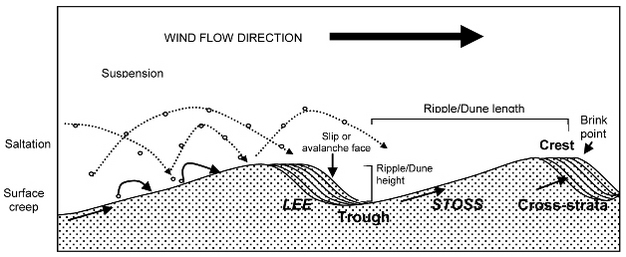
Regardless of the mechanism, as sediment is transported down-wind it produces bedforms known as ripples and dunes. Both aeolian ripples and dunes display an asymmetrical form comprising a longer, lower gradient (1°–8°) upwind slope known as the stoss slope, and a shorter and steeper downwind side or lee slope (32–36°) (Figure 2). The difference is a matter of size: ripples are small ridges of sand with a height (amplitude) typically less than 4 cm and wave lengths (crest to crest) less than 60 cm, while dunes have the same morphology (or form) as ripples but they are larger scale structures (photo 1). For both ripples and dunes, sediment is generally moved along the stoss to the crest, and when the net accretion of material reaches a critical state of overload (brink point) sediment avalanches down the lee of the dune (slip face). In classic transverse dunes — dunes formed at right angles to the dominant wind, and no vegetation present — this produces tabular cross-strata with a uniform dip direction parallel to the dominate wind direction as the dune migrates downwind (Photos 1 and 2).
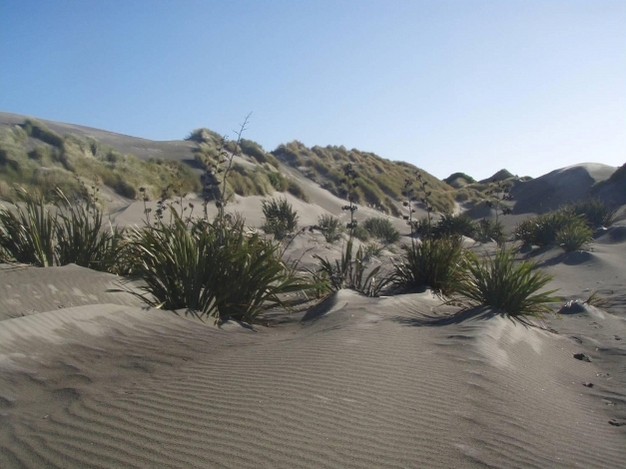
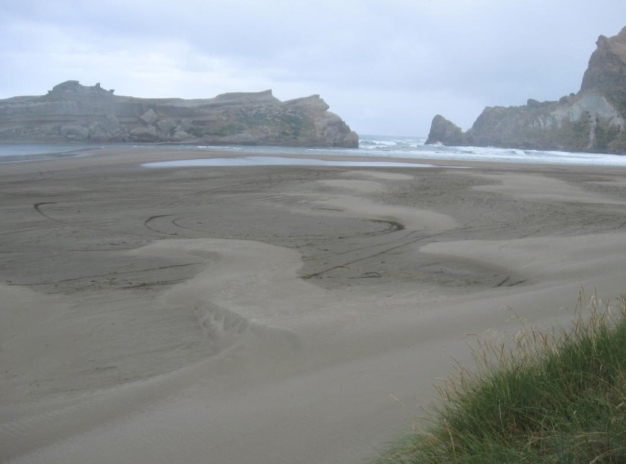
The availability of sediment for dune building is a function of sediment transport in the nearshore environment. The amount of sediment supplied from the beach to the back-beach environment is dependant on wind and wave power, tidal range, and beach type (Pye 1983, Hesp 1999). In general, sediment is transported landward via wave motion and swash to the foreshore, beachface, and backshore environments during periods of beach accretion. During low tides this sediment dries and is susceptible to aeolian (wind-blown) transportation. In addition to an abundant sediment supply there are numerous factors that control the availability of sediment to the backshore environment, the main ones being wind velocity and direction, moisture content, vegetation and beach morphology.
The moisture content of the sand controls the cohesion between individual grains. An increase in moisture content will significantly increase the cohesion of the sediment and reduce the capacity of the wind to initiate transportation. Accordingly, deflation (wind erosion) normally only occurs down to the level of damp sand, some vertical distance above the water table. As the water-table in permeable sand forms a horizontal or very gently sloping surface, deflation basins within dunefields, and the sand plains at the rear of transgressive dunes or between dune ridges, are usually relatively flat.
Vegetation is a significant controlling factor influencing the formation and morphology of coastal dunes (Olson 1958, Hesp 2002, Davidson-Arnott 2010). The coastal zone can be a very hostile environment for flora with high sedimentation rates, low nutrients, high salt spray, susceptibility to storm erosion and human recreation, and agricultural activity. Only a small group of plants are capable of colonising sand dunes (Hesp 1991). Nevertheless, in contrast to most desert dunes, vegetation usually plays an important role both in the initial formation and subsequent development of coastal dunes (Hesp 2002; photo 3). In the coastal environment, plants are the most common roughness element that can cause a reduction in the wind velocity and reduce the capacity of the wind to maintain aeolian transport and significantly increase the potential for trapping sand (Olson 1958, Hesp et al. 2009). For example, wind velocities decline rapidly close to the ground surface: if the ground is vegetated, the zone with very low, or zero, wind velocities increases in height from ~0.4 mm to ~10 mm above the ground surface, increasing the potential for sediment trapping and dune accretion. The growth of the pioneer species is actually stimulated by sand deposition, and plant species type is important in determining the morphology or form of the dune (Ranwell 1972, Hesp 1991, 1999). For this reason, artificial plantings of dune grass is a common method to encourage dune formation and growth.
Beach morphology also plays an important role in the supply and transportation of aeolian sediment into the back beach environment and dune formation. Changes in the slope and morphology of the beach face and back-shore profiles can increase or decrease wind velocity, as well as produce a roughness element, that can result in the deceleration of wind velocity and create turbulence resulting in variations in the rate of deflation, transport, and accumulation of sediment (Short & Hesp 1982, Sherman & Bauer 1993, Iversen & Rasmussen 1999). For example, dissipative beaches, with a wider foreshore and low gradient, provide less resistance to wind flow, and are more conducive to aeolian sand transport than the steeper reflective beaches (Short & Hesp 1982). In addition, dissipative beaches generally comprise finer sand which requires a lower threshold velocity to entrain sediment (Hesp 1999). In contrast, reflective beaches are generally composed of coarse grained material requiring higher threshold velocity to overcome the gravitational force and static friction. The steeper profile and the more irregular nature of the reflective beach also results in a zone of reduced wind speeds at the rear of the foreshore which is less conducive to aeolian transport (Short & Hesp 1982, Hesp 1999; Figures 3-5).
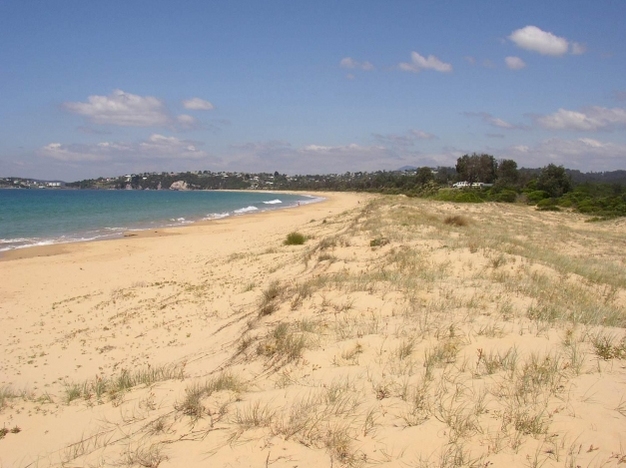
Summary
The movement of sediment from the beach face to the back beach via wind is by aeolian transport. Initiation of aeolian transportation (in the form of surface creep, saltation, or suspension) is dependant on the sedimentary characteristics, wind velocities, beach morphology, moisture content, and the degree of roughness elements present (e.g., driftwood and vegetation). The movement of sediment into the back beach environment often results in the formation of coastal dunes. The size and morphology of the dunes are determined by a complex interaction of suitable wind regime, sediment type and abundance, moisture and vegetation present, and the geomorphology of the nearshore and beach face.References and Recommended Reading
Bagnold, R. A. The Physics of Blown Sand and Desert Dunes. London, UK: Methuen, 1941.
Davis, J. L. Geographical Variation in Coastal Development. London, UK: Longman, 1980.
Davidson-Arnott, R. G. Introduction to Coastal Processes and Geomorphology. Cambridge, UK: Cambridge University Press, 2010.
Hesp, P. A. Ecological processes and plant adaptations on coastal dunes. Journal of Arid Environments 21, 165-191 (1991).
Hesp, P. A. "The beach backshore and beyond," in Handbook of Beach and Shoreface Morphodynamics, ed. A. D. Short (Brisbane, Australia: John Wiley and Son, 1999) 145-170.
Hesp, P. A. Foredunes and blowouts: Initiation, geomorphology and dynamics. Geomorphology 48, 245-268 (2002).
Hesp, P. A. et al. Storm wind flow over a foredune, Prince Edward Island, Canada. Journal of Coastal Research SI 56, 312-316 (2009).
Iverson, J. D. & Rasmussen, K. R. The effect of wind speed and bed slope on sand transport. Sedimentology 46, 723-731 (1999).
Olson, J. S. Lake Michigan dune development — plants as agents and tools in geomorphology. Journal of Geology 66, 345-351 (1958).
Pye, K. Coastal dunes. Progress in Physical Geography 7, 531-557 (1983).
Ranwell, D. S. Ecology of Salt Marshes and Sand Dunes. London, UK: Chapman and Hall, 1972.
Sherman, D. J. & Hotta, S. "Aeolian sediment transport: Theory and measurement," in Coastal Dunes: Form and Process, eds. K. F. Nordstrom, N. Psuty & B. Carter (Brisbane, Australia: John Wiley and Son, 1990).
Sherman, D. J. & Bauer, B. O. Dynamics of beach-dune systems. Progress in Physical Geography 17, 413-447 (1993).
Short, A. D. & Hesp, P. A. Wave, beach and dune interactions in southeastern Australia. Marine Geology 48, 259-284 (1982).

































